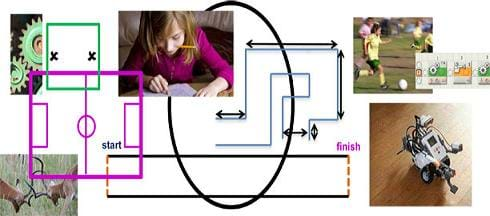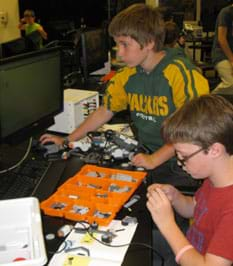
Summary
Through the two lessons and five activities in this unit, students' knowledge of sensors and motors is integrated with programming logic as they perform complex tasks using LEGO® MINDSTORMS® robots and software. First, students are introduced to the discipline of engineering and "design" in general terms. Then in five challenge activities, student teams program LEGO robots to travel a maze, go as fast/slow as possible, push another robot, follow a line, and play soccer with other robots. This fifth unit in the series builds on the previous units and reinforces the theme of the human body as a system with sensors performing useful functions, not unlike robots. Through these design challenges, students become familiar with the steps of the engineering design process and come to understand how science, math and engineering—including computer programming—are used to tackle design challenges and help people solve real problems. PowerPoint® presentations, quizzes and worksheets are provided throughout the unit.Engineering Connection

Our world would be a different place without engineers and all of the technologies, devices, structures and systems they create—vehicles, phones, bridges, medical devices, factories, appliances and software apps—just to name a few. The best way to learn about design and engineering is to take on a design challenge, following the steps of the engineering design process. In order to develop optimal solutions, engineers must identify criteria and specifications for the problem, recognize constraints to solving the problem and then use math and science principles to come up with solutions. Engineers design and test their solutions to evaluate how well they address the problem, an iterative process until success is achieved. In this unit, students apply the information they gathered from previous units and the two lessons in this unit to design solutions for a number of engaging challenges.
Unit Overview
This unit is composed of two lessons and five activities related to the integration of sensors and motors with programming logic in LEGO robots to perform complex tasks. The unit is the fifth in a series and follows Humans Are Like Robots (unit 1), Our Bodies Have Computers and Sensors (unit 2), What Is a Computer Program? (unit 3) and How Do Sensors Work? (unit 4).
Throughout this unit, each group of (2-4) students requires all or portions of the following items:
- LEGO MINDSTORMS EV3 robot, such as the EV3 Core Set (5003400) at https://education.lego.com/en-us/products/lego-mindstorms-education-ev3-core-set/5003400#lego-mindstorms-education-ev3 (includes programmable EV3 intelligent brick; 2 interactive servo motors; color, ultrasonic and 2 touch sensors; and many other components and instructions)
- LEGO MINDSTORMS Education EV3 Software 1.2.1, free online, you have to register a LEGO account first; at https://www.lego.com/en-us/mindstorms/downloads/download-software.
- computer, loaded with EV3 1.2.1 software
Alternative: LEGO MINDSTORMS NXT Set:
Note: This activity can also be conducted with the older (and no longer sold) LEGO MINDSTORMS NXT set instead of EV3; see below for those supplies:
- LEGO MINDSTORMS NXT robot, such as the NXT Base Set (includes programmable NXT intelligent brick; 3 interactive servo motors; sound, light, ultrasonic and 2 touch sensors; and many other components and instructions)
- LEGO MINDSTORMS Education NXT Software 2.1
- computer, loaded with NXT 2.1 software
Educational Standards
Each TeachEngineering lesson or activity is correlated to one or more K-12 science,
technology, engineering or math (STEM) educational standards.
All 100,000+ K-12 STEM standards covered in TeachEngineering are collected, maintained and packaged by the Achievement Standards Network (ASN),
a project of D2L (www.achievementstandards.org).
In the ASN, standards are hierarchically structured: first by source; e.g., by state; within source by type; e.g., science or mathematics;
within type by subtype, then by grade, etc.
Each TeachEngineering lesson or activity is correlated to one or more K-12 science, technology, engineering or math (STEM) educational standards.
All 100,000+ K-12 STEM standards covered in TeachEngineering are collected, maintained and packaged by the Achievement Standards Network (ASN), a project of D2L (www.achievementstandards.org).
In the ASN, standards are hierarchically structured: first by source; e.g., by state; within source by type; e.g., science or mathematics; within type by subtype, then by grade, etc.
See individual lessons and activities for standards alignment.
Subscribe
Get the inside scoop on all things TeachEngineering such as new site features, curriculum updates, video releases, and more by signing up for our newsletter!Unit Schedule
Each lesson and activity is designed to take one to two 50-minute sessions, for a total of ten 50-minute sessions for the unit. See Table 1 for the suggested order to conduct the lessons and activities.
- Lesson 1: What Is Engineering and What Is Design? (1 session - 50 mintues)
- Activity 1: Maze Challenge (2 sessions - 100 minutes)
- Lesson 2: What Are Gears and What Do They Do? (1 session - 50 mintues)
- Activity 2: Hare and Snail Challenges (2 sessions - 100 minutes)
- Activity 3: Sumobot Challenge (1.5 sessions - 75 minutes)
- Activity 4: Line-Follower Challenge (1.5 sessions - 75 minutes)
- Activity 5: Robot Soccer Challenge (1 session - 50 mintues)
More Curriculum Like This

Students learn about how touch sensors work, while reinforcing their similarities to the human sense of touch. They look at human senses and their electronic imitators, with special focus on the nervous system, skin and touch sensors.

Through six lesson/activity sets, students learn about the functioning of sensors, both human and robotic. The overall framework reinforces the theme of the human body as a system with sensors—that is, from an engineering perspective.

Through four lesson and four activities, students are introduced to the logic behind programming. Starting with very basic commands, they develop programming skills while they create and test programs using LEGO® MINDSTORMS® robots. The unit is designed to be motivational for student learning, so th...

Students are introduced to an important engineering element—the gear. Different types of gears are used in many engineering devices, including wind-up toys, bicycles, cars and non-digital clocks. Students learn about various types of gears and how they work in machines.
Copyright
© 2014 by Regents of the University of Colorado; original © 2013 Curators of the University of MissouriContributors
Sachin Nair, Riaz Helfer, Pranit Samarth, Satish S. NairSupporting Program
GK-12 Program, Computational Neurobiology Center, College of Engineering, University of MissouriAcknowledgements
This curriculum was developed under National Science Foundation GK-12 grant no. DGE 0440524. However, these contents do not necessarily represent the policies of the National Science Foundation, and you should not assume endorsement by the federal government.
Last modified: October 17, 2020







User Comments & Tips